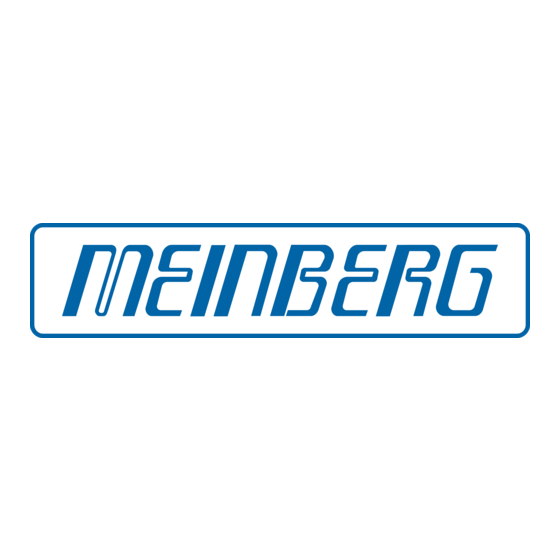
Table of Contents
Advertisement
Quick Links
Advertisement
Table of Contents

Subscribe to Our Youtube Channel
Summary of Contents for Meinberg DCF77C51
- Page 1 FUNKUHREN Technical Information Operating Instructions DCF77C51...
- Page 2 Werner Meinberg Auf der Landwehr 22 D-31812 Bad Pyrmont Telefon: ++49 52 81 - 9309-0 Telefax: ++49 52 81 - 9309-30 Internet : http://www.meinberg.de E-Mail : info@meinberg.de May 28, 2002...
-
Page 3: Table Of Contents
Pulse Outputs ............... 10 DIL-Switches ................11 Technical Specifications ............12 CE Label ..............13 Format of the Meinberg Standard Time String ... 14 Connectors ..............15 DSUB-25 Connector Pin Assignments ....... 15 Component Layout ............17 Usage of the Current Loop Interface ......18 Active Output to Passive Input ..... -
Page 5: General Information About Dcf77
General Information about DCF77 The radio remote clocks made by Meinberg receive the signal from the long wave transmitter DCF77. This long wave transmitter installed in Mainflingen near Frank- furt/Germany transmits the reference time of the Federal Republic of Germany. This time reference is either the Central European Time (Mitteleuropäische Zeit, MEZ) or... -
Page 7: Dcf77C51
DCF77C51 The radio remote clock DCF77C51 has been designed for applications where only the serial interface is used to transmit information on date and time to other devices. The clock has an enhanced LF receiver and is manufactured using surface mounting technology (SMT). -
Page 8: Installation
Installation The radio remote clock has a built in AC power supply. After the power cable has been connected, a green LED labeled Netz indicates that the clock is ready to operate. If the antenna cable has been connected to both the antenna and the clock's BNC connector, the brighness of the LED labeled Feldstärke reflects the signal strength of the 77.5 kHz carrier. -
Page 9: Serial Port
Serial Port The asynchronous serial port can be configured by a DIL switch located inside the clock's case. When the clock is beeing shipped, the levers of the DIL switch have been set to some defaults which are marked by asterisks (*) in the tables below. If one of the switch settings has to be changed, the upper part of the clock's case must be removed by detaching the 4 screws located at the edges of the cover. -
Page 10: Framing
Framing Levers 4 and 5 of the DIL switch are used to select the framing type of the serial port: SW-4 SW-5 Framing Framing types are usually labeled with three-character abbreviations. The first character represents the number of data bits (7 or 8), the second character indicates whether parity checking is used or not (N=no parity, E=even parity) and the last character gives the number of stop bits to use (1 or 2). -
Page 11: Dil-Switches
DIL-Switches SW1-SW3 Baudrate 600/1200/2400/4800/9600/19200 SW4 - SW5 Framing 7E1 / 7E2 / 8N1 /8N2 SW6 - SW7 Output Mode per second / per minute / on request Timezone UTC / (MESZ/MEZ) reserved SW10 Serial Input 20mA / RS232 * default settings: framing: 7E2 / baudrate: 9600 / output mode: per second / timezone: MESZ/MEZ... -
Page 12: Technical Specifications
Technical Specifications RECEIVER: Synchronous demodulator with automatic gain control bandwidth: approx. 50Hz ANTENNA: Active external ferrite antenna in a plastic case Length of the cable: up to more than 100m RF AMPLITUDE, MODULATION: Indicated by LED TIMECODE CHECK: Parity and consistency checking over a period of two minutes RF distortions indicated by both LED and a status character in the serial output string Without RF signal the clock runs on XTAL... -
Page 13: Ce Label
TIME ZONE: MEZ/MESZ=CET/CEST, or UTC OUTPUT STRING: see "Format of the Meinberg Standard Time String" SERIAL LINE DRIVERS: Output: RS-232 and 20mA current loop (active or passive) Input: RS-232 or 20mA current loop (active or passive), selectable by jumper CONNECTORS:... -
Page 14: Format Of The Meinberg Standard Time String
Format of the Meinberg Standard Time String The Meinberg Standard Time String is a sequence of 32 ASCII characters starting with the STX (start-of-text) character and ending with the ETX (end-of-text) character. The format is: <STX>D:dd.mm.yy;T:w;U:hh.mm.ss;uvxy<ETX> The letters printed in italics are replaced by ASCII numbers whereas the other characters are part of the time string. -
Page 15: Connectors
Connectors Name Type Signal Cable Serial Interface 25 pin SUB-D RS232 shielded data line 20mA Pulse Outputs pulse per second pulse per minute Antenna 77.5kHz shielded coaxial line (RG174/RG58) Power Supply 230V /AC power supply cord DSUB-25 Connector Pin Assignments P_SEC out, collector RxD in P_SEC out, emitter... -
Page 17: Component Layout
Component Layout... -
Page 18: Usage Of The Current Loop Interface
Usage of the Current Loop Interface The current loop interface can be wired to work in one of two modes: active output drives passive input, or passive output to active input. Active Output to Passive Input If the clock's current loop output shall be wired to operate as active output, a connection from the pin labeled +pass_out to Vcc (+5V) must be provided. -
Page 19: Passive Output To Active Input
Passive Output to Active Input If a current loop output shall be wired to operate as passive output, the input wust be wired to operate as active input. A connection from the pin labeled +pass_in to Vcc (+5V) must be provided. The pin labeled -act_in is pulled down to the auxiliary -15V supply, which must be made available by the user.



Need help?
Do you have a question about the DCF77C51 and is the answer not in the manual?
Questions and answers